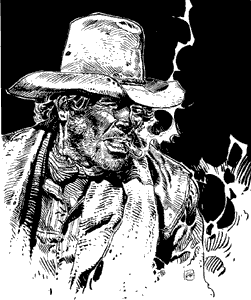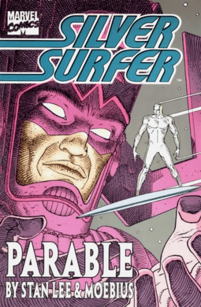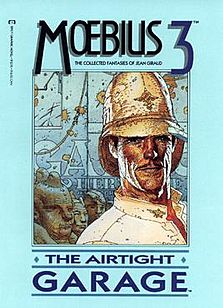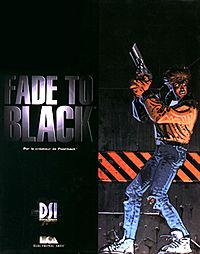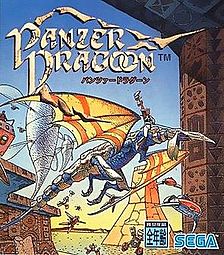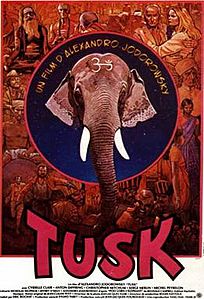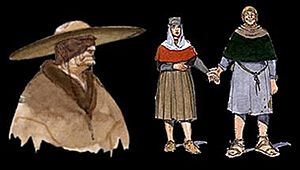Jean Giraud facts for kids
Quick facts for kids Jean Giraud |
|
|---|---|
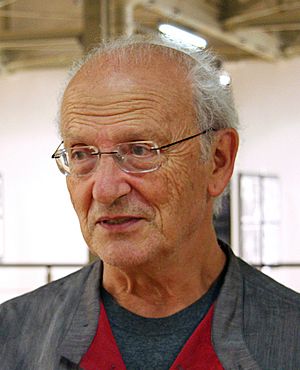
Giraud in 2008
|
|
| Born | Jean Henri Gaston Giraud 8 May 1938 Nogent-sur-Marne, France |
| Died | 10 March 2012 (aged 73) Montrouge, France |
| Nationality | French |
| Area(s) | Writer, Artist |
| Pseudonym(s) | Gir, Moebius, Jean Gir |
|
Notable works
|
|
|
Notable collaborations
|
Alejandro Jodorowsky, Jean-Michel Charlier |
| Awards | full list |
| Spouse(s) |
Claudine Conin
(m. 1967–1994)Isabelle Champeval
(m. 1995–2012) |
| Children | Hélène Giraud (1970), Julien Giraud (1972), Raphaël Giraud (1989), Nausicaa Giraud (1995) |
| Signature | |
Jean Henri Gaston Giraud (born May 8, 1938 – died March 10, 2012) was a famous French artist, cartoonist, and writer. He worked in the French-Belgian comics style, known as bandes dessinées.
Giraud was known worldwide by his pen name Mœbius. He also used the name Gir for his Blueberry series and his Western-themed paintings. Famous artists like Federico Fellini, Stan Lee, and Hayao Miyazaki admired his work. Many people say he was the most important bandes dessinées artist after Hergé.
His most famous works include the Blueberry series. He created this with writer Jean-Michel Charlier. It featured one of the first antiheroes in Western comics. As Mœbius, he created many science fiction and fantasy comics. These had a very imaginative, surreal, and almost abstract style. Some of these works are Arzach and The Airtight Garage of Jerry Cornelius. He also worked with filmmaker Alejandro Jodorowsky on a movie idea for Dune and the comic series The Incal.
Mœbius also helped create storyboards and designs for many science fiction and fantasy movies. These include Alien, Tron, The Fifth Element, and The Abyss. The Blueberry comic was made into a movie in 2004 by French director Jan Kounen.
Contents
- Growing Up and Early Art
- Artistic Journey
- Movie Work
- Video Games and Art
- Artistic Style
- Passing Away
- Legacy and Influence
- Filmography
- Video Games
- Documentaries
- See also
Growing Up and Early Art
Jean Giraud was born in Nogent-sur-Marne, France, on May 8, 1938. His parents divorced when he was three. He was mostly raised by his grandparents. This separation influenced his choice to use different pen names later on. As a child, Giraud found comfort in a small movie theater. He loved watching American B-movie Westerns there. This started his lifelong passion for the genre.
When he was 9 or 10, Giraud began drawing Western comics. He went to a boarding school where he discovered Belgian comic magazines like Spirou and Tintin. In 1954, at age 16, he started art school. He became friends with future comic artists Jean-Claude Mézières and Pat Mallet. He and Mézières shared a love for science fiction and Westerns. This led to a close, lifelong friendship.
In 1956, he left art school to visit his mother in Mexico. He stayed there for nine months. The Mexican desert and its vast landscapes deeply impressed him. These experiences later appeared in many of his famous works. After returning to France, he worked as an artist for a Catholic publisher called Fleurus. From 1959 to 1960, he served in the military in Germany and Algeria. He worked as an illustrator for an army magazine. This was his second experience with different cultures, which also influenced his later comics as "Mœbius".
Artistic Journey
Western Comics Beginnings
At 18, Giraud drew humorous Western comics for Far West magazine. The editor thought he was good at funny comics, but not realistic ones. However, Giraud kept drawing realistic Westerns.
Early Influences and Mentorship
From 1956 to 1958, Giraud worked at Fleurus. He drew realistic Western comics and illustrations for magazines like Fripounet et Marisette. His style was heavily influenced by Belgian comic artist Joseph "Jijé" Gillain. Jijé was a major inspiration for many young French artists.
In 1961, after military service, Giraud became Jijé's apprentice. Jijé was a top comic artist in Europe and often mentored young talents. Giraud helped Jijé with his Western series Jerry Spring. Giraud inked one of the stories. He learned a lot from Jijé, who he called his "master."
Working for Hachette
After working with Jijé, Giraud illustrated a history reference work for Hachette. This job taught him to create art with gouache paints. This skill was useful for his Blueberry covers. At Hachette, he met Claudine Conin, who later became his first wife in 1967. They had two children, Hélène and Julien. Hélène also became a graphics artist.
The Pilote Era and Blueberry
In October 1963, Giraud and writer Jean-Michel Charlier started the comic strip Fort Navajo for Pilote magazine. Jijé sometimes helped with the drawings when Giraud was busy. The main character, Lieutenant Blueberry, quickly became the focus of the series. His look was based on actor Jean-Paul Belmondo.
The Blueberry series became Giraud's most famous work in France and Europe. At first, the comics had a simple drawing style. But Giraud gradually developed a darker, more realistic style. This was inspired by Western movies like Soldier Blue and the films of Sergio Leone. After 1968, artists gained more creative freedom. The Blueberry strip became more adult and explored deeper themes.
Giraud left the series and publisher in 1974. He wanted to explore his "Mœbius" alter ego more. He was invited to Los Angeles to work on the Dune movie project. This was his first time working with Alejandro Jodorowsky. Even though the Dune project didn't happen, Giraud started creating comics as "Mœbius" for a new magazine he co-founded, Métal Hurlant.
Jodorowsky introduced Giraud to the writings of Carlos Castaneda. Castaneda wrote about shamanism and Native American wisdom. These ideas deeply influenced Giraud's "Mœbius" art, especially dream sequences. He even secretly added some Castaneda elements to a Blueberry comic.
Returning to Blueberry
Giraud returned to the Blueberry series in 1979 as a free-lance artist. He and Charlier had disagreements with their publisher, Dargaud, about money. They left Dargaud and started a new Western comic, Jim Cutlass. The Blueberry series eventually returned to Dargaud after Charlier passed away.
When Charlier died in 1989, Giraud took over writing the main Blueberry series. The last album he created for the publisher was "Apaches" in 2007. Blueberry has been translated into 19 languages. While Giraud gained worldwide fame as "Mœbius," Blueberry remained his most successful work in France. He admitted that Blueberry was like a "sponsor" for his Mœbius work, providing the income to explore his artistic ideas.
Science Fiction and Fantasy Comics (Mœbius)
The "Mœbius" name was born in 1963. Giraud used it for 21 comic strips in a satire magazine called Hara-Kiri. He enjoyed the artistic freedom there, but Blueberry demanded too much of his time. The name "Mœbius" then went unused for comics for a decade. However, Giraud continued to use it for illustrations in science fiction books and music album covers.
L'Écho des savanes and Métal Hurlant
In 1974, Giraud truly brought back the Mœbius name for comics. His first story as Mœbius was "Cauchemar Blanc" ("White Nightmare"). It was about a serious social issue. This work surprised many readers who didn't realize "Jean Gir[aud]" and "Mœbius" were the same person.
Later in 1974, Giraud co-founded the publishing house "Les Humanoïdes Associés" with other artists. They started the monthly magazine Métal hurlant ("Screaming Metal") in December 1974. The English version was called Heavy Metal. This magazine introduced Giraud's work to North America. Mœbius's famous series "The Airtight Garage" and "Arzach" both started in Métal hurlant. This magazine changed the world of French-Belgian comics. It also greatly influenced American comic artists and filmmakers.
"Arzach" (1974–1975) was a wordless comic created directly in color. It aimed to bring new life to comics. It follows the main character flying on a pterodactyl through a fantastic world. The lack of words gives the story a timeless feel.
His series The Airtight Garage, which began in 1976, is known for its non-linear story. Readers can interpret the movement and time in many ways. The series features Major Grubert, who builds his own universe on an asteroid.
In 1980, Giraud started his famous L'Incal series with Jodorowsky. However, Giraud felt the success of "Mœbius" was becoming too demanding. He moved from Paris to Pau in 1980 to escape the busy comic scene.
Tahiti and New Ideas
From 1985 to 2001, he created his six-volume fantasy series Le Monde d'Edena. These stories were influenced by new spiritual teachings. Giraud and his family lived in Tahiti from 1983 to 1984. Then they moved to California, USA. While in Tahiti, Giraud briefly used a third pen name, Jean Gir.
Working with Marvel Comics
In 1985, Giraud's wife, Claudine, started Starwatcher Graphics in the US. This company aimed to release his art in a special way. They worked with Marvel Comics' Epic imprint. From 1987 to 1994, Epic published most of Mœbius's work in the US. This included his Blueberry Western comics. In the English-speaking world, all his work was published under the "Mœbius" name.
He drew a two-issue Silver Surfer miniseries (1988-1989) for Marvel. It was written by Stan Lee. This series won an Eisner Award in 1989. Giraud's Silver Surfer was even mentioned in the 1995 movie Crimson Tide.
Giraud also created superhero art for Marvel and DC Comics. He designed trading cards featuring characters from his Mœbius universe. He lived in California for five years. This period inspired his art book Made in L.A.. He won several awards during this time, including an Inkpot Award and more Eisner and Harvey Awards. He also learned to speak English.
Later Works and Personal Life
In late 1989, Giraud returned to France. His family had already moved back. His marriage with Claudine ended in 1994. In 1995, Giraud married Isabelle Champeval. They had two children, Raphaël and Nausicaa. Isabelle's sister, Claire, often helped color Giraud's later works.
Giraud finished the Blueberry album "Arizona Love" after Charlier died. He then took over writing the main Blueberry series. He also wrote the Marshal Blueberry spin-off series.
As "Mœbius," he continued The Aedena Cycle and Madwoman of the Sacred Heart series. From 2000 to 2010, he published Inside Mœbius, a six-volume autobiography. In it, he appeared as a cartoon character, talking with his younger self and other characters from his comics.
In 2007, Giraud drew part of the XIII comic series. Later in life, he revived his Arzak character in a new series. He also added to The Airtight Garage series. In his last years, Giraud used a graphic computer tablet for his art. This helped him because his eyesight was failing.
Illustrations and Writing for Others
Giraud illustrated books, magazines, and music albums throughout his career. He also created promotional art for companies. For example, he made Blueberry art for Lois Jeans & Jackets in 1978. He illustrated the science fiction novel Project Pendulum by Robert Silverberg and the French edition of The Alchemist by Paulo Coelho.
In the mid-1990s, Giraud designed box cover art for video games like Fade to Black and Panzer Dragoon. Later, he became a concept artist for other games. In 1999, he illustrated the Paradiso volume of Dante Alighieri's La Divina Commedia. His illustrations for Paradiso were inspired by Gustave Doré's engravings.
Giraud also wrote comics for other artists, such as Jacques Tardi and Claude Auclair. He wrote story ideas for movies like Les Maîtres du temps and Little Nemo: Adventures in Slumberland. He also wrote philosophical poems for his Mœbius art books. In 1998, he wrote his autobiography, Moebius-Giraud: Histoire de mon double.
Movie Work
Giraud's first movie attempt was a short animated Western in 1957 with his friend Jean-Claude Mézières. Later, in 1974, he was invited by Alejandro Jodorowsky to work on a movie adaptation of Dune. This project was never finished, but it opened doors for Giraud in Hollywood.
Director Ridley Scott hired Giraud as a concept artist for his 1979 science fiction thriller Alien. Giraud's designs for the crew's spacesuits were used directly in the movie. Scott admired Giraud's art and cited his comic "The Long Tomorrow" as an influence on his movie Blade Runner.
In 1981, the animated film Heavy Metal was released. The "Taarna" section of the movie was inspired by Giraud's "Arzach." Although Giraud was not directly involved, he was amused by the inspiration.
Giraud also worked on the Disney science fiction movie Tron (1982) as a concept and storyboard artist. He also collaborated with director René Laloux on the animated movie Les Maîtres du temps (Time Masters). For Time Masters, Giraud designed the characters and the overall look.
Giraud also created movie posters for films like Touche pas à la femme blanche ! (1974) and Tusk (1980).
He initiated and co-produced an animated science fiction movie called Internal Transfer (also known as Starwatcher). This project, unfortunately, did not get enough funding and was never completed. However, the concept art he created for it became the basis for his collaboration with Geof Darrow on the City of Fire art portfolio.
He continued to work as a concept artist for movies like Masters of the Universe (1987), Willow (1988), and The Abyss (1989). He was also the conceptual designer and story writer for the Japanese animated film Little Nemo: Adventures in Slumberland (1989).
After returning to France in 1989, Giraud worked on Warner Bros.' Space Jam (1996). In 1997, he was a concept artist for Luc Besson's The Fifth Element. This was special because he worked with his lifelong friend Jean-Claude Mézières. His daughter Hélène also worked on the movie.
In 2005, the Chinese movie Thru the Moebius Strip was released. It was based on a story by Giraud, who also helped design and produce it. His last movie contribution was as a concept designer for the 2012 animated film Strange Frame.
Movie Adaptations of His Work
In 1991, his short graphic novel "Cauchemar Blanc" was made into a film by Mathieu Kassovitz. In 2002, his Arzach character was adapted into a series of animated shorts for French television called Arzak Rhapsody. Giraud wrote, drew, and co-produced these shorts. His young daughter Nausicaa even did some voice-overs.
The Blueberry comic series was adapted into the movie Blueberry: L'expérience secrète in 2004. There had been earlier attempts to make a Blueberry movie, but they didn't work out.
In 2010, a short story from Le Monde d'Edena called "La planète encore" ("The Still Planet") was made into an animated short. Giraud was one of the directors. In 2021, it was announced that Oscar winner Taika Waititi would direct a movie based on Jodorowsky and Moebius's graphic novel The Incal.
Video Games and Art
After designing box art for video games, Giraud became a concept designer for the 1997 game Pilgrim: Faith as a Weapon. He designed costumes for the game. In 2004, he provided character concept designs for the Japanese video game Seven Samurai 20XX.
Giraud's art has also inspired many video games. For example, an arcade called The Airtight Garage was based on his work. Games like Jet Set Radio Future (2002), Gravity Rush, Sable (video game) (2021), and Rollerdrome (2022) have visuals inspired by Mœbius.
Artistic Style
Giraud used many different working methods. These included etchings, black and white drawings, and colorful watercolors. Some fans criticized his Blueberry works because he changed the style. However, his innovations were key to Blueberry's early success.
To tell his work apart, Giraud used a brush for his "Gir" work and a pen for his "Mœbius" work. He was known for drawing very quickly. In a documentary, he said his different styles might come from his short-sightedness. When he drew without glasses, he focused on fine details. With glasses, he saw the bigger picture. He often started with glasses for a global view, then took them off for details.
Passing Away
Jean Giraud passed away in Montrouge, France, on March 10, 2012, at age 73. He had been battling cancer. Many friends and people from the comic world attended his funeral. The French Minister of Culture, Frédéric Mitterrand, spoke at the service. He said that with Giraud's death, France lost "two great artists" (referring to both Giraud and Mœbius). Giraud left his estate to his second wife, Isabelle, and his four children.
Legacy and Influence
Jean Giraud is considered one of the most influential bandes dessinées artists after Hergé. Many artists worldwide have said he greatly influenced their work. After his death, several comic journals published special tribute issues. These featured testimonials and art from many comic artists.
- Hayao Miyazaki, the famous manga author and anime filmmaker, was a longtime friend of Giraud. Giraud even named his daughter Nausicaa after a character in Miyazaki's Nausicaä of the Valley of the Wind.
- Mike Mignola, creator of Hellboy, said that seeing Arzach was like "seeing a door open."
- William Gibson, a pioneering cyberpunk author, said that "The Long Tomorrow" comic was "a key moment" for him.
- "The Long Tomorrow" also influenced director Ridley Scott for his movie Blade Runner.
- George Lucas, who invited Giraud to work on his movie Willow, wrote that Giraud's work "transcends the boundaries of the medium."
- British author and comic artist Neil Gaiman said that Giraud's art was "like nothing else."
- Italian filmmaker Federico Fellini said, "I consider him more important than Doré."
- Brazilian author Paulo Coelho paid tribute to Giraud, saying he was "one of the greatest artists of all time."
- Benoît Mouchart, artistic director at the Angoulême International Comics Festival, said Giraud "changed the way people think about comics."
- French Culture Minister Frédéric Mitterrand said that Giraud cemented the status of bande dessinée as "the 9th art" in France.
Awards and Honors
Giraud received many awards and honors throughout his career:
- 1969 & 1970: Prix Phénix Paris (France), for Lieutenant Blueberry.
- 1972: "Best Realistic Artist" Special Award from the National Cartoonists Society (USA).
- 1973: Shazam Award (USA), for Lieutenant Blueberry.
- 1975: Yellow Kid Award, Lucca Comics & Games (Italy).
- 1977: Angoulême International Comics Festival (France) Best French Artist.
- 1979: Adamson Award (Sweden), for Lieutenant Blueberry.
- 1980: Yellow Kid Award, Lucca Comics & Games (Italy).
- 1981: Grand Prix de la ville d'Angoulême (France).
- 1982: Fantafestival Award (Italy) for Les Maîtres du temps (Best Children's Film).
- 1985: Grand Prix for the graphic arts, Angoulême International Comics Festival (France).
- 1985: Named Chevalier de l'Ordre des Arts et des Lettres, a French civilian knighthood.
- 1986: Inkpot Award (USA).
- 1988: Harvey Award (USA), for Moebius album series.
- 1989: Eisner Award (USA), for Silver Surfer (Best Finite Series).
- 1989: Harvey Award (USA), for Incal.
- 1991: Eisner Award (USA), for Concrete (Best Single Issue).
- 1991: Harvey Award (USA), for Lieutenant Blueberry.
- 1997: Inducted into the Harvey Award Jack Kirby Hall of Fame (USA).
- 1997: World Fantasy Award (USA) (Best Artist).
- 1998: Inducted into the Will Eisner Award Hall of Fame (USA).
- 2000: Max & Moritz Prizes (Germany), Special Prize for outstanding life's work.
- 2001: Spectrum Grandmaster (USA).
- 2004: Albert-Uderzo Award (France) as "Mœbius" (Life-time Achievement).
- 2011: Inducted into the Science Fiction Hall of Fame (USA).
- 2011: Named Chevalier de l'Ordre National du Mérite (France).
- 2012: The national comics museum in France named a building "Le Vaisseau Mœbius" ("The Ship Mœbius") in his honor.
- 2018: Asteroid 109435 Giraud was named in his memory.
- 2020: Inducted into the Society of Illustrators Hall of Fame (USA).
Filmography
- Alien (1979) – Concept artist
- The Time Masters (1982) – Character design, storyboards
- Tron (1982) – Concept artist, storyboards
- Masters of the Universe (1987) – Concept artist
- Willow (1988) – Concept artist
- The Abyss (1989) – Concept artist
- Little Nemo: Adventures in Slumberland (1989) – Conceptual designer, story writer
- The Fifth Element (1997) – Production design
- Blueberry (2004) – Based on his comic
- Thru the Moebius Strip (2005) – Story, production designer, co-producer
- Strange Frame (2012) – Concept designer
Video Games
- Video games Mœbius worked on:
- Fade to Black (1995) – Box cover art
- Panzer Dragoon (1995) – Box cover art
- Pilgrim: Faith as a Weapon (1997) – Concept art
- Seven Samurai 20XX (2004) – Character design
- Video games inspired by Mœbius's art:
- The Airtight Garage (1999) – An arcade and bar based on his work.
- Jet Set Radio Future (2002) – Artwork and graphics inspired by his style.
- Gravity Rush – Artwork and graphics inspired by his style.
- Sable (video game) (2021) – Heavily inspired by Mœbius artwork.
- Rollerdrome (2022) – Features Mœbius-inspired visuals.
- Swordship (2022) – Minimalist graphics with color tones similar to Mœbius comics.
- Aquamarine (2022) – Artwork inspired by his style.
- Synergy (2023) – Strong, bright Mœbius-esque visuals.
Documentaries
- 1987: The Masters of Comic Book Art – About comic artists.
- 1994: La Constellation Jodorowsky – Features Giraud and Alejandro Jodorowsky discussing their work.
- 1994: Blueberry – About the comic series.
- 1997: Jean [Gir]aud's – About Giraud's Blueberry art.
- 2000: Mister Gir & Mike S. Blueberry – Shows Giraud creating art and visiting events.
- 2002: Fellini: I'm a Born Liar – Giraud designed the poster for this film.
- 2005: The Visual Element – Giraud and Jean-Claude Mézières discuss their work on The Fifth Element movie.
- 2007: Moebius Redux: A Life in Pictures – A biographical documentary about Giraud.
- 2010: Métamoebius – An autobiographical film co-written by Giraud.
See also
 In Spanish: Jean Giraud para niños
In Spanish: Jean Giraud para niños


